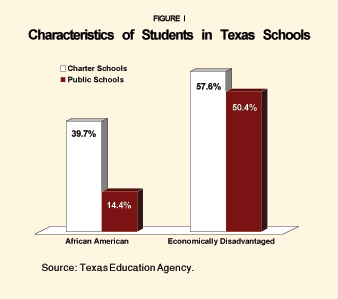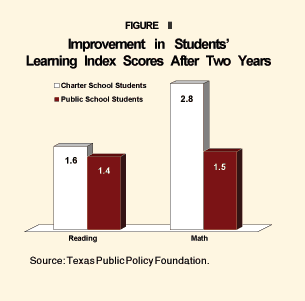Charter schools are independent public schools that are freed from many of the bureaucratic rules and regulations preventing innovation and flexibility in traditional public schools. They provide educational choices for families dissatisfied with their child's assigned public school. Over the last decade, the charter movement – which began as a single school with 20 students – has blossomed into more than 2,400 schools and half a million students across the country. To date, 38 states and the District of Columbia have charter school laws of various kinds.
Charter Schools in Texas: An Overview.
With 212 operating charter schools, Texas ranks behind only Arizona with 419 and California with 358. During the 2001-2002 school year, more than 50,000 students were enrolled in state-approved charter schools.
The first Texas charter schools opened their doors in 1996. The state currently allows up to 215 open-enrollment charter schools, plus an unlimited number of university-sponsored and locally approved charters. For the 1999-2000 school year, which provides the latest statistics available, 214 charters were granted and 146 schools were open for the entire year.
According to Texas Education Agency statistics, a Texas charter school student is more likely to be African-American, less likely to be white and more likely to be economically disadvantaged than a traditional public school student:
- African-Americans comprise 39.7 percent and whites 20.5 percent of students enrolled in Texas charter schools, while traditional public schools enroll 14.4 percent African-Americans and 40.9 percent whites. [See Figure I.]
- Charter schools that enroll predominantly one racial or ethic group (90 percent or more) are more likely to be minority (27 schools are African-American and 20 are Hispanic) than white (6 schools).
- Overall, 57.6 percent of students enrolled in Texas charter schools are economically disadvantaged to the degree that they qualify for federally subsidized lunches, a somewhat higher proportion than the 50.4 percent who qualify in traditional public schools.

Student Performance in Texas Charter Schools.
Charter schools are a relatively new phenomenon, and each school is different by design. As a result, it is difficult to make meaningful comparisons and at least as difficult to make generalizations. But the available data does permit some limited evaluations.
Examining Aggregate Scores. The performance of charter school students appears to lag behind that of traditional public school students. Using the latest organized data, from the 2000 Texas Assessment of Academic Skills (TAAS) test of a minimum skills:
- Only 43.1 percent of charter students passed all the test sections, compared to a state average of 79.9 percent.
- The same holds true for individual subject tests: There was a 23.2 percentage point differential in reading (64.2 percent passing in charters vs. a state average of 87.4 percent); 29.8 percentage points (58.4 percent vs. 88.2 percent) in writing; and 34.9 percentage points in mathematics (52.5 percent vs. 87.4 percent).
Such simple head-to-head comparisons look bad for charters. However, it is important to keep in mind that charter schools typically have a student population that is more difficult to educate because of their high concentration of at-risk and disadvantaged children. In addition, the reasons students leave their assigned public school and enter charter schools may include poor academic experiences in one-size-fits-all public schools.
Student Academic Performance Over Time.
A more meaningful way to measure how schools prepare students for the future is to examine how test scores change from one year to the next for students who attend the same school for two years in a row. Using this method, researchers can come closer to capturing the effect an individual school has on a student's scores.
Three facts emerge from examining student scores over time:
1. Students who enter a charter school experience a consistent first-year decline in test scores. Passing rates of students who entered an open enrollment charter school declined by 0.7 percentage points, from 63.1 percent in 1999 to 62.3 percent in 2000.
Because new schools open frequently and new students enter charter schools each year, the first-year decline charter school students experience biases downward the aggregate scores of these schools' TAAS passing rates relative to traditional public schools in any given year. The student population of charter schools grew 23 percent in 1999 and 13 percent in 2000; 77 percent of the growth in 1999 and 13 percent of the growth in 2000 was due to the opening of new charters.
2. Students who remain in charter schools for consecutive years have strong academic gains. TAAS passing rates have improved for children enrolled in charter schools in each of the years charter schools have been in operation in Texas:
- Passing rates for students remaining in open enrollment charter schools for two consecutive years increased 6.9 percentage points in reading from 1999 to 2000 and 9.1 percentage points in math.
- Passing rates for students who remained in charter schools serving primarily at-risk students for two years improved at a greater rate: 11.7 percentage points in reading from 1999 to 2000 and 6.9 percentage points in math.
3. Performance of students enrolled in charter schools improved at a rate greater than that of traditional public school students. A recent Texas Public Policy Foundation study compared the performance of students in charter schools and traditional public schools using the Texas Learning Index (TLI), which is derived from raw TAAS scores and controls for variations across years and grades. For the years 1999 and 2000:
- Students who stayed in charter schools for two years experienced a TLI increase of 1.6 points in reading and 2.8 points in math; by comparison, index scores for students who stayed in traditional public schools increased 1.4 points in reading and 1.5 points in math. [See Figure II.]
- The progress of at-risk students in charters and traditional public schools was roughly the same, while the progress of non-at-risk charter school students (1.5 point increase in reading and a 2.5 point increase in math) far outpaced the progress of comparable students in public schools (0.7 point increase in both reading and math).
Thus, although charter students lag behind traditional public school students in head-to-head rankings for now, they appear to be improving at a faster rate.
Conclusion.
Charter schools allow for innovative approaches and show satisfying academic results. They also are cost-efficient. According to the Texas Public Policy Foundation, the average charter spends at least $4,000 less per pupil than a traditional public school with identical characteristics. Charter schools are still a relatively new phenomenon and are just beginning to take shape. Still, the evidence of their performance to date suggests that charter schools have much to offer and should be allowed to thrive.
Matt Moore is a policy analyst with the National Center for Policy Analysis.